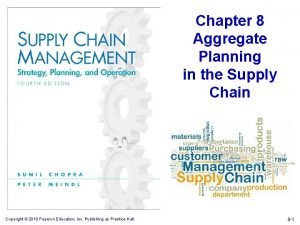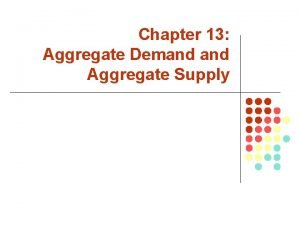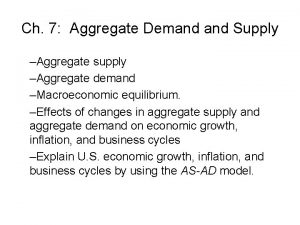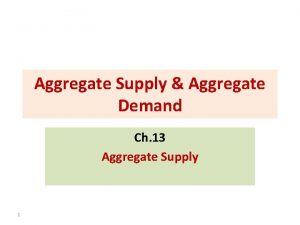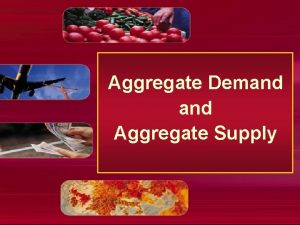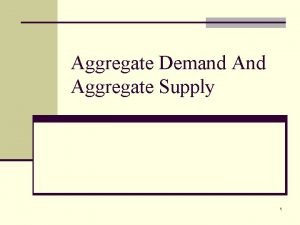Aggregate Supply 1 What is Aggregate Supply Aggregate










- Slides: 10

Aggregate Supply 1

What is Aggregate Supply? Aggregate Supply is the amount of goods and services (real GDP) that firms will produce in an economy at different price levels. (The supply of everything by all firms. ) Aggregate Supply differentiates between short run and long-run and has two different curves. Short-run Aggregate Supply • Wages and Resource Prices will NOT increase as price levels increase. (fixed = “sticky”) Long-run Aggregate Supply • Wages and Resource Prices WILL increase as price levels increase. (variable = flexible)

Short-Run Aggregate Supply In the Short Run, wages and resource prices will NOT increase as price levels increase. Example: • A firm currently makes 100 units that are sold for $1 each. The only cost is $80 for labor. How much is profit? • Profit = $100 - $80 = $20 What happens in the SHORT-RUN if price level doubles? • Now 100 units sell for $2, TR=$200. How much is profit? • Profit = $200 - $80 = $120 With higher profits, the firm has the incentive to increase production.

Short-Run Aggregate Supply Price Level AS AS is the production by all the firms in the economy Real domestic output (GDPR)

Long-Run Aggregate Supply In the Long Run, wages and resource prices WILL increase as price levels increase. Same Example: • The firm has TR of $100 an uses $80 of labor. • Profit = $100 - $80 = $20. What happens in the LONG-RUN if price level doubles? • Price level doubles, so now TR=$200. • In the LONG RUN workers demand higher wages to match higher prices. So labor costs double to $160. • Profit = $200 - $160 = $40, but REAL profit is unchanged. If REAL profit doesn’t change the firm has no incentive to increase output.

Long- Run Aggregate Supply In long run, price level increases but GDPR doesn’t Price level LRAS Full-Employment (Trend Line) QFE GDPR We assume that in the long-run the economy will be producing at full employment.

Shifters Aggregate Supply R. A. P.

Shifts in Aggregate Supply An increase or decrease in national production can shift the curve right or left AS 2 AS 1 Price AS 3 Level Real domestic output (GDPR)

Shifters of Aggregate Supply 1. Change in Resource Prices of Domestic and Imported Resources (Increase in price of Canadian lumber…) (Decrease in price of Chinese steel…) Supply Shocks (Negative Supply shock…) (Positive Supply shock…) Inflationary Expectations (If people expect higher prices in the future…) If people expect higher prices in the future, workers will demand higher wages and labor costs will increase. This will decrease AS.

Shifters of Aggregate Supply 2. Change in Actions of the Government (NOT Government Spending) Taxes on Producers (Lower corporate taxes…) Subsidies for Domestic Producers (Lower subsidies for domestic farmers…) Government Regulations (EPA inspections required to operate a farm…) 3. Change in Productivity Technology (Computer virus that destroy half the computers…) (The advent of a teleportation machine…)
 Ad curve graph
Ad curve graph Unit 3 aggregate demand aggregate supply and fiscal policy
Unit 3 aggregate demand aggregate supply and fiscal policy Tax multiplier formula
Tax multiplier formula Chapter 33 aggregate demand and aggregate supply
Chapter 33 aggregate demand and aggregate supply Unit 3 aggregate demand aggregate supply and fiscal policy
Unit 3 aggregate demand aggregate supply and fiscal policy Tableau cannot mix aggregate and non aggregate
Tableau cannot mix aggregate and non aggregate Aggregate planning in supply chain management
Aggregate planning in supply chain management Aggregate supply and demand graph
Aggregate supply and demand graph Which aggregate supply curve has a positive slope
Which aggregate supply curve has a positive slope Ad as
Ad as Aggregate supply shifters
Aggregate supply shifters






